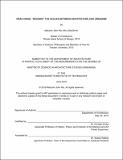Drag hinge : "reading" the scales between architecture and urbanism
Author(s)
Rio, Malcolm John(Malcolm John Rio UltraOmni)
Download1135865843-MIT.pdf (82.00Mb)
Other Contributors
Massachusetts Institute of Technology. Department of Architecture.
Advisor
Arindam Dutta.
Terms of use
Metadata
Show full item recordAbstract
Ballroom is a queer subculture that emerged out of drag performance(s) and is largely comprised of queer people of color (QPOCs) in New York City during the early 1970s. In ballroom, contestants "walk" categories that emulate archetypal traits of another gender, sex, or social class, or battle through dance, commonly known as "voguing." Most ballroom participants belong to one of a series of groups known as "Houses" which are led by a Mother and/or Father who provides wisdom and guidance to the other members of the House, known as children. In pre-1990s ballroom, known as "Old Way," both houses and ballroom performance rapidly evolved to provide ever more inclusive safe-spaces for the many young QPOCs disproportionately affected by the economic and social hardships prevalent during the later-half of the twentieth century. This thesis looks at how Old Way ballroom used the politics of the Image, what Stuart Hall refers to as the contestation and struggle over what is represented in the media, as a means to reclaim collective political agency and compares it against the ways Image is utilized by the various apparatuses and institutions composing mainstream American social order as well as by stakeholders in New York City's contemporaneous urban development as a biopolitical means of controlling urban space. In so doing, this thesis seeks to position ballroom's history as an architectural and urban text which offers an urban analysis of New York City from a QPOC perspective as well as a related social critique of its uneven development.
Description
This electronic version was submitted by the student author. The certified thesis is available in the Institute Archives and Special Collections. Thesis: S.M. in Architecture Studies (Urbanism), Massachusetts Institute of Technology, Department of Architecture, 2019 Cataloged from PDF version of thesis. Includes bibliographical references (pages 154-160).
Date issued
2019Department
Massachusetts Institute of Technology. Department of ArchitecturePublisher
Massachusetts Institute of Technology
Keywords
Architecture.